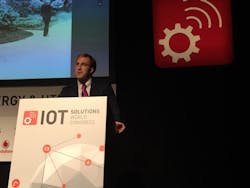Industrial IoT and the Smart Grid Connection
As a still-emerging technology to drive the next generation of power grids, the smart grid concept is finding increasing levels of support from governments worldwide as a way of addressing energy independence, climate change and resilience to emergencies. On its face, there might not seem to be any connection between the smart grid and smart manufacturing, but there are key areas of overlap, such as the increasing deployment of sensors for greater data collection, more focus on data aggregation and analysis at the edge, industrial networking technology deployments and, of course, the concept that ties all of this together — the Internet of Things.
During his presentation at the Industrial Internet Consortium’s IoT Solutions World Congress 2016 in Barcelona, Spain, Thomas Nuth of Moxa focused on the key challenges and trends driving development of the smart grid and how technologies and strategies similar to those used in industrial production are playing a key role. Though the energy industry has its own unique certifications and regulations, this industry is also faced with connecting disparate networks and system interoperability issues. Sound familiar?
Referencing the Smart Grid Architecture Model, Nuth highlighted the communication layer, which connects the architecture’s protocol and data model. He pointed to this layer as being the lynchpin to smart grid system connection and interoperability. It is also the area of focus for Moxa.
“As a supplier of industrial networking and computing products, we want to connect the smart grid’s system of systems to extend the life of capital equipment and bring data to the enterprise,” Nuth said. “Our whole idea is to be open source. It doesn’t matter how the power is generated—whether it comes from traditional sources or renewables—we want to enable it to be scalable for advanced city infrastructure projects like those involving telematics or conventional storage to power households. Our role is to provide actionable data so power can be shifted to where it needs to be in the smart grid.”
Just like we see in industrial production scenarios, the massive amounts of data generated by the deployment of pervasive sensing devices in smart grid applications is making the idea of offloading massive amounts of data to the cloud for analysis unrealistic. With products like its UC-8100 edge computing device, Moxa is focused on keeping large amounts of data “off of the cloud and putting it in localized, embedded computers,” Nuth said. “Analyzing data at this level is critical to delivering sensor-to-control visibility for monitoring and diagnostics applications to detect and recognize anomalous equipment activity.”
Illustrating the benefits of such anomalous equipment activity detection, Nuth referenced Duke Energy’s recent Internet of Things initiative to place sensors on industrial assets, connect them, and relay relevant data to workers via mobile devices.
“In this project, Duke Energy focused on remote monitoring of equipment, diagnostics and prognostics, data integration and visualization, and enhancement of workforce processes,” said Nuth. “In the first year of implementation, Duke Energy saved $8 million. They saved another $2 million in the following year. These savings were the result of finding sources of equipment failures early and leveraging people, processes and technology to address them before a breakdown occurred.”
Nuth added that, as the project continues, Duke Energy is “increasing the number of potential failures it finds each year as more sensors are deployed,” thereby continuing a high level of bottom line savings for the company.
About the Author
David Greenfield, editor in chief
Editor in Chief

Leaders relevant to this article:
